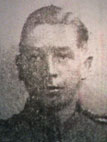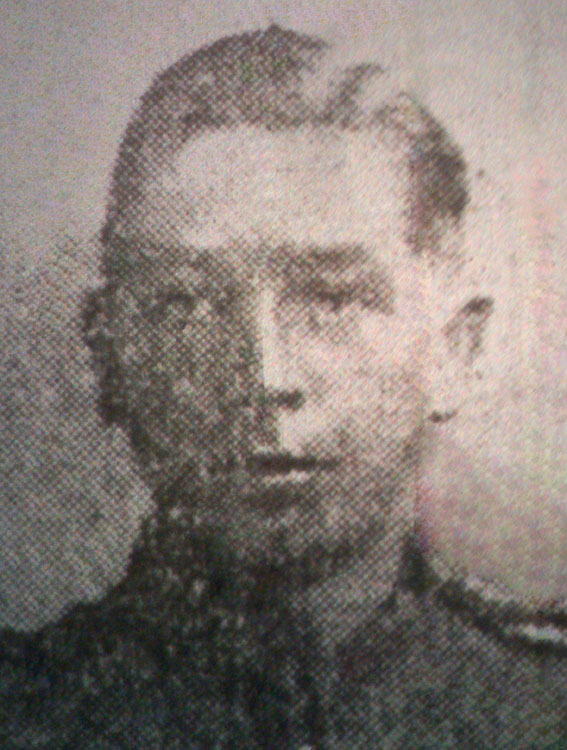 |
Remembrance
- The Yorkshire Regiment, First World War L/Sgt Arthur James HOWES. 33102 Close window to return to main page |
 |

Photo from the Norwich Mercury dated November 10, 1917
Lance Serjeant Arthur James HOWES, 33102.
10th Battalion Yorkshire Regiment. Formerly 2984 Norfolk Regiment. Son of
Arthur Walter and Beatrice Annie Howes, of 2, Beckfield, Northwold, Brandon,
Norfolk. Died 4 October 1917. Aged 20.
Born Methwold (Brundon), Enlisted Norwich, Resided Methwold (Brundon).
Commemorated on Panel 52 to 54 & 162A, TYNE COT MEMORIAL.
Peter Clarke has provided the following additional information on L/Sgt Arthur James Howes;-
SDGW records that Lance Sergeant 33102 Arthur James Howes was Killed in Action on the 4th October 1917 whilst serving in France and Flanders with the 10th Battalion, Alexandra Regiment. He was born and resident Methwold, ‘Brundon’, and enlisted Norwich. He was formerly 2984 Norfolk Regiment.
The Medal Index Card for Corporal 33102 Arthur J. Howes, Yorkshire Regiment,
is held at the National Archive under reference WO 372/10/71846.
He had previously been Corporal 9163 Northumberland Fusiliers.
Source: discovery.nationalarchives.gov.uk/details/r/D2979422
He qualified for the British War Medal and the Victory Medal. The card is noted “Dead” but holds no other information.
The associated Service Medal Roll shows he had previously served with the 4th Battalion, Northumberland Fusiliers.
His Service Records do not appear to have survived the incendiary attack during the Blitz on the Warehouse where all the Other Ranks Army Service Records were stored.
No obvious Missing Persons enquiry received by the International Red Cross.
No obvious Soldiers Will or Civil Probate for this man.
There is a report in the edition of the Norwich Mercury dated Saturday,November 7th, 1914, which probably relates to his father. In a piece entitled “EAST ANGLIANS ON ACTIVE SERVICE” there is a round up of volunteers from this various locations including METHWOLD.- Two more Methwold men have responded to their country’s call, namely, Mr. Arthur Howes, landlord of the Windmill Inn and Mr. J. Custon, district insurance agent for the Liverpool Victoria Legal Friendly Society, Both these old ex-non-commissioned officers formerly belonged to the 2nd Battalion Suffolk Regiment.
1897 – Birth………………….
The birth of an Arthur James Howes was registered with the Civil Authorities
in the Marylebone District of London in the April to June quarter, (Q2), of
1897.
The most likely marriage of his parents occurred in the April to June quarter of 1897 when an Arthur Walter Howes married a Beatrice Annie Higgins.
1901 Census of England and Wales.
The 3 year old Arthur James Howes, born London, was recorded living at The
Windmill Inn, High Street, Methwold. This was the household of his married
mother, Beatrice Annie, aged 25 and an Innkeeper, born Brixton. As well as
Arthur she has a second son, Geoffrey Bazelgette Howes, born Methwold. There
are also four lodgers in the household.
His father, the 33 year old Serjeant Arthur ‘Wm’ Howes, born Methwold, Norfolk, was recorded in Barracks at Bury St Edmunds, Suffolk.
1911 Census of England and Wales
The Howes family were reunited and living at the Windmill Inn. Head of the
household is Arthur W. Howes, (aged 43, a Road Labourer, born Methwold) and
his wife Beatrice A, (35, born Brixton, London). The couple have been married
14 years and have had 6 children, all then still alive. They were:-
Arthur J…….aged 13….born Marylebone, London
Geoffrey B….aged 11….born Methwold
Beatrice A….aged 9……born Methwold
Evelyn L……aged 6……born Methwold
Constance J…aged 3……born Methwold
Adia Isabel..aged 7 months…born Methwold
There were also four lodgers.
Until September 1911 the quarterly index published by the General Registrars
Office did not show information about the mothers’ maiden name. A check
of the General Registrars Office Index of Birth for England and Wales 1911
– 1983 shows potentially three more children of parents Arthur and Beatrice.
All were registered in the Thetford District with the mothers maiden name
shown as Higgins.
Alfred K Howes……..Q4 1912
Frank Howes…………Q3 1914
Mary Howes………….Q2 1918
Beatrice & Arthur appear to have been licensees up until the Windmill
Inn closed at some point in the 1920’s.
Source: www.norfolkpubs.co.uk/norfolkm/methwold/methww.htm
On the day……………………………..
The 21st Div was to occupy the high ground above the Reutelbeek valley (Beek
- Stream), across which was the spur on the Polderhoek Chateau stood.
Four tanks were tasked to assist. In this battle the first VC for the new
Tank Corps was awarded- Act Capt C ROBERTSON VC (he died winning it). Not
all objectives were taken on 4th October and it dragged on for several days.
The German official history described it as 'the black day of October 4th'.
The German's had planned their own attack on 4th October. The British attack
began 10 minutes before theirs. Many German troops were at their jump off
points when the British Artillery opened up. The British and ANZAC troops
captured over 4,000 prisoners on the Second Army front. The German 45th Reserve
Division lost 83 officers and 2,800 other ranks. Ludendorff said in his memoirs
- ' The battle on the 4th October was extraordinarily severe, and we only
came through it with enormous losses. It was evident that the idea of holding
the front line more densely, adopted at my last visit to the front in September,
was not the remedy.
The 3/4th Queen's took over from the 8/Leicester's on the night of 2/3rd October. The rest of the Brigade came up on 3rd Oct, taking up positions on the eastern side of Polygon Wood. These positions were in full view of the enemy in daylight.
The attack was led by 3/4th Queen's, with the second objective taken by 12/13 Northumberland Fusiliers on the right and 10/Yorkshire on the left; 1/Lincoln was to be in reserve. However, on the approach to the front line, the 10/ Yorkshire were badly mauled by German shelling in Glencourse Wood and Black Watch Corner.
1/ Lincoln took two and a half hours to cover four miles from Zillebeke Lake
to their position, They arrived at about midnight. Heavy shelling continued
over the whole area during the night. The moving troops were silhouetted against
the light of the burning ammo dumps. Under cover of darkness (!) guiding tapes
were put out by the three leading battalions and posts (lookouts not wooden!)
were pushed forward to Polygonbeek so that the enemy would remain unaware
of what was taking place.
At 5 am the CO of 1/Lincoln , Lt-Col LP EVANS, returned from looking at the
assembly positions and , acting on alternative Brigade orders, switched his
battalion with 10/Yorkshire, as the latter had suffered such heavy casualties.
At 6am the attack began. The first obstacle was the Polygonbeek which was muddy and covered with entangled wire. The creeping barrage moved on before the men had all cleared the area. 10/Yorkshire moved into the front line as soon as the Brigade had moved forward.
There were several unexpected and well hidden concrete emplacements on the eastern bank of the Polygonbeek. Each had a garrison of 20-30 men and 3 machine guns. As soon as the creeping barrage had passed, they opened fire on the advancing troops and caused many casualties. It was also near here that a German officer offered his surrender but when a Lt moved up to him, he took his revolver out and shot the Lt, killing him. The German was riddled with bullets by the men who had witnessed it.
The OC 1st Lincoln Regiment passed his two leading companies through the northern companies of the Queen's, scrambled across the bog of Jetty Warren and rushed the first objective, killing large numbers of Germans.
The Northumberland Fus backed up the Queen's and reached Judge Trench. The trench was full of 19th Reserve Div troops recently brought from Riga on the Russian front.
'The bayonet was freely used and a large number of fleeing Germans were shot. Hand grenades and Phosphorous bombs cleared the mebus and rifle grenades the more distant shell holes. One mebus was set on fire and the garrison either burnt to death or were shot. Few prisoners were taken.
The general sit rep (situation report) at 6-30am -
3/4th Queen's consolidating along the whole of the first objective, less one company digging in its immediate support.
On left, in continuation of Judge trench, elements of 1/S Staffs, on the right the KOYLI of 64th brigade.
In advance on the left 1/Lincoln forming for the attack on the second objective- C and D companies were in front; A and B reorganised in Judge trench. A was moved up shortly before the advance to the second line.
In the trenches on the right the 12/13 Northumberland Fus were forming up for the same purpose. 5th Div though were held up at Polderhoek Chateau and this had a knock on effect - 64th Brigade were suffering enfilade fire by machine gun - 12/13th found their flank in the air when at 08-10 the advance to objective two began. They also had machine gun fire from the Chateau to contend with. They advanced 150 yards and had to dig in.
The 1/Lincoln on the left were slightly protected by the curve of the spur, and only subjected to indirect fire from the Chateau, some machine guns from Judge Copse and the two isolated mebus and numerous snipers in shell holes. They obtained their final objective though and consolidated. The line whilst not continuous was tenable.
archiver.rootsweb.ancestry.com/th/read/ENG-LINCSGEN/2004-...
Postscript……………………………..
The Army Register of Soldiers Effects shows that that he appears to have actually owed money at the time of his death but this was written off in January 1918. Post war the War Gratuity for this soldier was paid to his father Arthur in February 1920.
-----------------> Return to top of the page